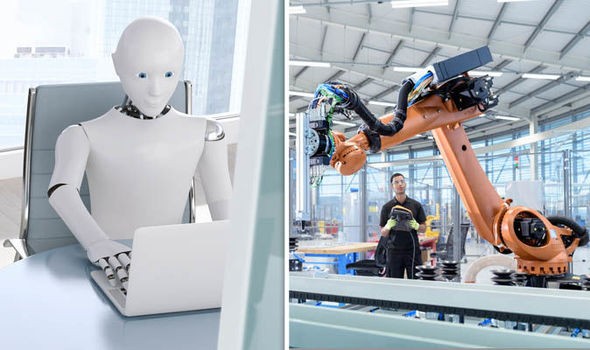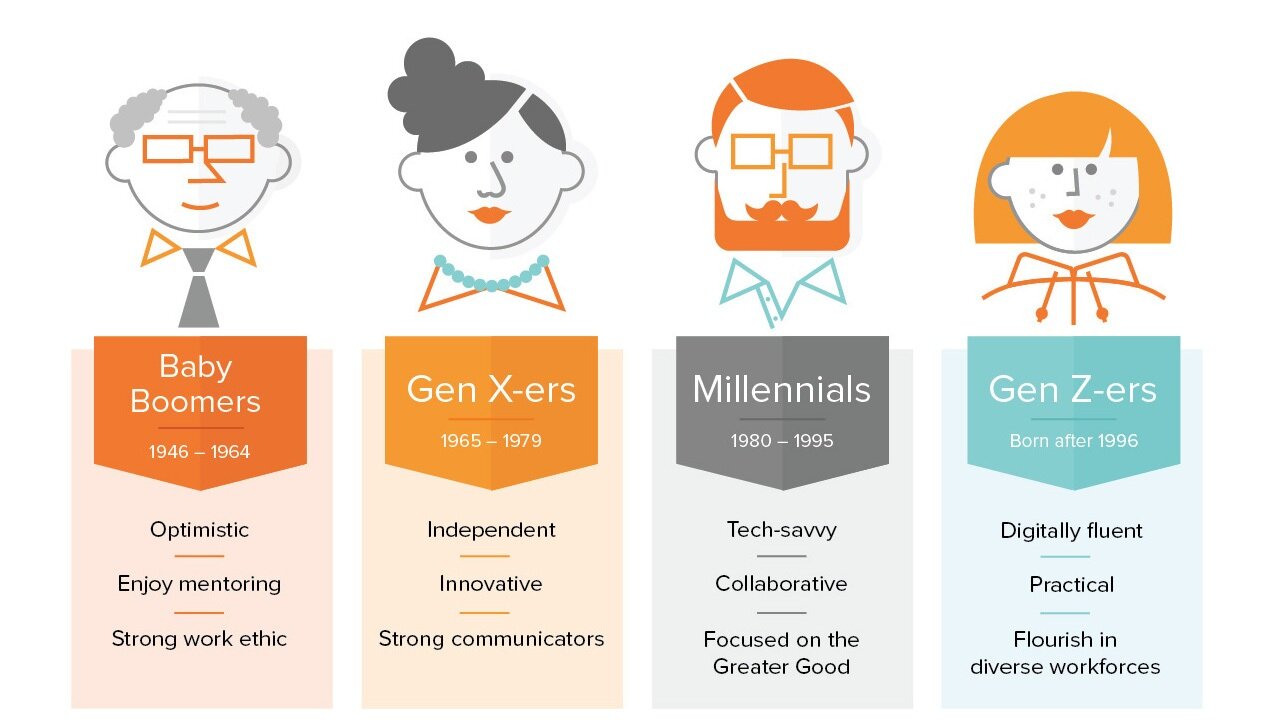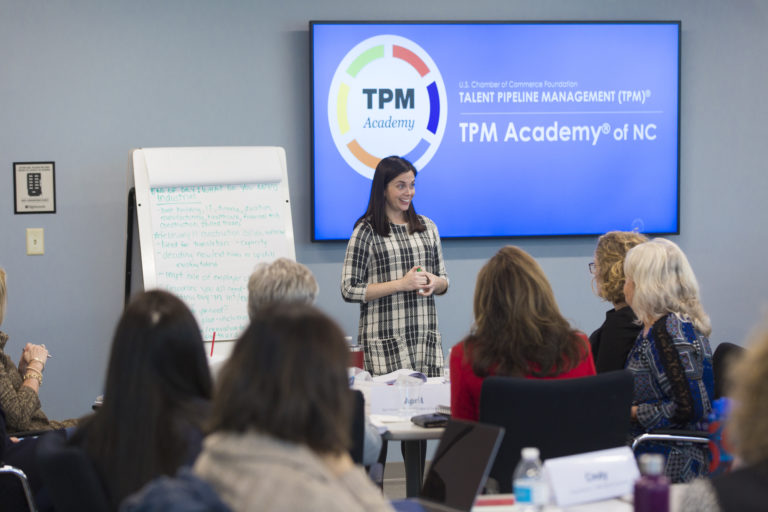Workplace/Workforce Disruption in North Carolina
Automation (substituting human labor with machines) is a long-term trend expected to primarily impact lower-paid, semi-skilled occupations like office administration, production, transportation, and food preparation (Muro et al., 2019). Powered by large language models such as ChatGPT, recent advances in generative artificial intelligence (AI) have greatly expanded the range of tasks that can be automated. Potentially vulnerable occupations include language and literature teachers, writers, legal services, finance, insurance, and accounting (Felten et al., 2023).

Several interrelated trends are disrupting workplaces and the workforce, creating uncertainty for employers, workers, and communities. Short-term trends spurred by the COVID-19 pandemic include 1) the shift to remote work and 2) labor shortages across industries and professions known as the Great Resignation. As pandemic impacts have receded, hybrid work-from-home models have emerged as the “new normal,” creating challenges for central business districts/office markets and opportunities for suburban and rural areas with amenities for remote workers. The Great Resignation peaked in 2022 when about 50.5 million people left their jobs. Reflecting uncertain economic conditions, the quit rate fell in 2023 to near pre-pandemic levels. While there was an increase in layoffs in 2023, the labor market continues to be tight, and most North Carolina workers returned to work within three months of their lay-off date (Berger-Gross 2023c). Irrespective of these fluctuations, there is an ongoing mismatch between available jobs and workforce skills, highlighting the need for a pipeline of talented workers entering the workforce.
The Challenge
North Carolina has experienced a historically tight job market over the last several years as the nation emerged from the pandemic and unprecedented numbers of workers left their jobs. The labor market loosened in 2022 and the first half of 2023 as the Federal Reserve raised interest rates. While the quit rate declined from an all-time high of 3.9% in 2021 to 2.7% in April 2023, North Carolina’s labor participation rate remains low due to the aging of the state’s population (Berger-Gross 2023a, b). Employers continue to have difficulty finding qualified workers, a particularly severe problem in the public sector.
The LMI Institute’s automation exposure score shows North Carolina has a slightly higher share of jobs vulnerable to automation than the U.S. Urban and suburban parts of the state have lower employment shares in vulnerable occupations than rural ones (Harrington, 2023). While predictions regarding automation vary, a reasonable conclusion is that a shift in required job skills (towards cognitive, non-routine tasks) rather than widespread job losses will be the end result. Education and training are key to equipping workers to adapt to these changes.
In addition, generations have different expectations of their workplaces. Gen Z employees (b. 1995-2012) value flexibility, opportunities to learn and grow, and environments that prioritize social responsibility and diversity. Millennials (b. 1980-1994) value a fun and meaningful work environment and work-life balance and expect their ideas to be heard. Gen X employees (b. 1965-1979) tend to be independent, practical, and hard-working. Often juggling family responsibilities, they value flexibility, healthcare benefits, and financial security. Known for their goal-oriented work ethic, Baby Boomers (b. 1946-1964) value exciting and impactful work, public recognition, and the opportunity to share their expertise. By understanding these differences, employers can attract talent and leverage the diverse abilities of a multi-generational workforce (Paychex 2023).
Potential Responses
Short-Term
- Establish cross-sectoral working groups to address workplace/workforce disruption
- Assess strengths, weaknesses, and opportunities related to demographic, workplace, and workforce trends
- Revise workplace models and job descriptions to attract workers from different generations
- Initiate Talent Pipeline Management (TPM) programs
Medium-Term
- Expand TPM programs
- Partner with schools, universities, community colleges, and businesses to prepare/upskill/reskill workers
- Develop amenities and infrastructure to increase competitiveness in the job market, building on local assets and opportunities
- Establish regional workplace/workforce resource hubs for local governments
Long-Term
- Monitor the long-term impacts of artificial intelligence, automation, and other drivers of change on workplaces and the workforce
- Develop lifelong education and training programs to instill the skills and mindset needed for workers to succeed in a changing economy
- Position local communities, regions, and North Carolina as a whole as models for workplace/workforce innovation in different contexts
Key Stats
- During the pandemic lockdown, the percentage of persons working from home doubled in two weeks (from 31% to 62%) (Brenan 2020). In 2023, 12.7% of full-time employees worked from home, and 28.2% worked a hybrid model. 98% of workers wanted to work remotely at least part of the time (Forbes Advisor 2023).
- The share of all workers in occupations with high exposure to automation in North Carolina ranges from a low of 26.1% in the Durham-Chapel Hill MSA to a high of 49.2% in the Hickory-Lenoir-Morgantown MSA (NC Department of Commerce 2023b).
- 35% of businesses in 2023 have adopted artificial intelligence (AI), and 9 out of 10 businesses support its use for competitive advantage. By 2025, AI is projected to eliminate 85 million jobs and create 97 million new ones for a net gain of 12 million (Webster, 2023).
Example: Talent Pipeline Management
Developed by the U.S. Chamber of Commerce Foundation, Talent Pipeline Management (TPM) is a demand-driven, employer-led approach to close the skills gap by building pipelines of talent aligned to dynamic business needs. The North Carolina Chamber of Commerce Foundation is expanding the U.S. Chamber’s TPM program across the state to help businesses in multiple sectors transform their workforce pipelines using a curriculum organized around six strategies. Located in the Centralina COG, Gaston County is an example of a successful program application. Partnering organizations include the Gaston Business Association, Gaston County Economic Development Association and Workforce Development Board, Gaston County Schools, local colleges, businesses, and others.
TPM strategies can be applied to public agencies as well as private businesses. Local governments can attract younger workers by promoting their value to communities, providing benefits, flexibility, and job security, and offering training and career development programs.
Click here to complete our survey about North Carolina drivers of change!
References
Felten, Ed, Manav Raj, and Robert Seamans (2023). How Will Language Modelers like ChatGPT Affect Occupations and Industries?
Forbes Advisor (2023). Remote Work Statistics and Trends in 2023
Berger-Gross, Andrew (2023a). January 2023 NC Economy Watch: The Labor Market is Loosening, but It’s Still Very Tight, NC Department of Commerce, The Lead Feed, January 13, 2023
Berger-Gross, Andrew (2023b). June 2023 NC Economy Watch: The Tight Labor Market and the Not-So-Great Resignation, NC Department of Commerce, The Lead Feed, June 12, 2023
Berger-Gross, Andrew (2023c). November 2023 NC Economy Watch: A Closer Look at Recent Layoff Activity, NC Department of Commerce, The Lead Feed, November 6, 2023
Brenan, Megan (2020). U.S. Workers Discovery Affinity for Remote Work, Gallup
Muro, Mark, Robert Maxim, and Jacob Whito (2019). Automation and Artificial Intelligence: How machines are affecting people and places, Brookings Institution
Harrington, Neil (2023). Automation’s potential labor market impacts in different regions of North Carolina, NC Department of Commerce, The Lead Feed, April 12, 2023
Paychex (2023). Generational Differences in the Workplace: Managing a Multi-Generational Workforce
Webster, Mark (2023). 149 AI Statistics: The Present and Future of AI at your Fingertips, AuthorityHacker, based on AI survey and third-party sources



